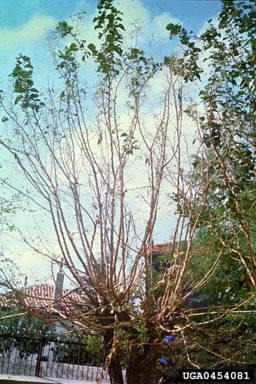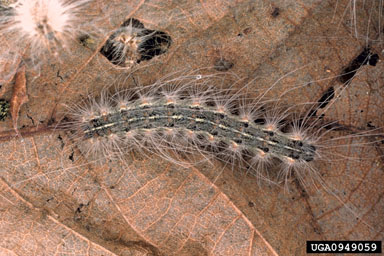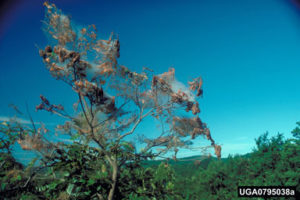You may have noticed spider-like webs showing up on your bushes and trees recently. In some areas, the webs are so prevalent that it looks like trees and bushes have been decorated for Halloween. The culprit? Fall Webworms.
Our Arborists report seeing an abnormally high population of Fall Webworms this year. This insect is a native caterpillar that builds webs and feeds on shade trees, ornamentals, and shrubs. Despite the name, Fall Webworms tend to show up in August and early September. If left untreated, these insects will defoliate numerous branches and possibly the entire tree. Between the defoliation and giant webs, this pest turns trees into an eyesore. But it’s not just aesthetics, the defoliation caused by this pest can weaken the tree causing an overall drop in health and increased susceptibility to other pests and diseases, especially in newly planted or stressed trees.
Species Targeted By Fall Webworms:
Fall webworms target almost all shade, fruit, and ornamental trees except conifers. In the United States, about 90 species of trees are regularly affected. In our area, our Arborists suggest keeping an eye on your hickories, walnuts, elms, birches, cherries, redbuds, willows, oaks, mulberries, crabapples, and maples.
Signs & Symptoms Of Fall Webworms:
To spot Fall Webworms keep an eye out for the signs and symptoms below.
- Webs constructed around leaves at the end of branches
- Hundreds of larvae, excrement, and dried leaf fragments will be in the webs
- Webs will make jerking movements when the caterpillars are alarmed.
- Defoliation
- Caterpillars on your tree and shrubs
- Young larvae are pale yellow with two rows of black marks along their body
- When fully grown, they are covered in white hairs that originate from black and orange spots



Fall Webworms Or Eastern Tent Caterpillars?
Homeowners commonly mistake Fall Webworms as Eastern Tent Caterpillars. Despite similar symptoms and looks, you can easily tell these insects apart by the time of year you see them in. Fall Webworms appear during late summer/early fall while Eastern Tent Caterpillars appear during early spring. Overall Fall Webworms tend to do less lasting damage to trees/shrubs than Eastern Tent Caterpillars because they defoliate the tree later in the year. The reason late-season defoliating pests don’t do as much damage, is because the tree has already had a good amount of the season to collect and store energy from photosynthesis. Giving the tree enough energy to push out new leaf growth next year. Although any defoliation over 25% will begin to affect the vigor of the tree no matter what time of year, causing health issues and increased susceptibility to other pests and diseases.
Fall Webworm Treatment:
Thankfully, you can easily control Fall Webworms using systemic insecticide treatments and foliage insecticide sprays. Depending on the severity of the infestation, the location of the tree, and the tree species our Arborists will recommend some version of manual removal, treatments to kill the webworms this season, and preventative treatments to keep them from coming back next season.
If you think your tree/shrubs have Fall Webworms, we can help! Book an appointment with an arborist online or call 703.573.3029



